Panzerfaust
WW II German Infantry Anti-Tank Weapons
Page 2: Faustpatrone & Panzerfaust
Panzerfaust Usage
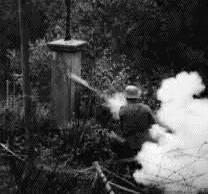
Caution was to be paid to the backblast of the weapon, it created an explosion
blast of two to three meters ( 6.5 - 10 ft.) behind the tube.
Therefore on many Panzerfausts, especially the early Panzerfaust 30
m, a warning in large red letters printed on the upper rear part of
the tube advised to stay clear:
Achtung! Feuerstrahl! ("Beware ! Fire Jet !";
see pic. below of four Panzerfaust 30 in delivery crate).
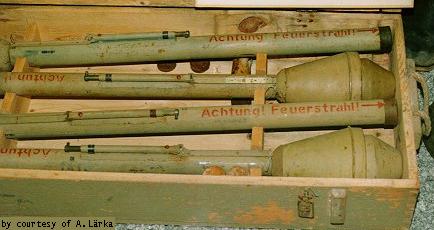 Sometimes
other variations of this warning were stenciled on the upper rear. But
the backblast wasn't only dangerous to bystanders: the rear of the firing
soldier had to be free of obstacles for at least 3 m (10 ft.), otherwise
heavy burns on the back of the firing soldier would result. Officially
the rear of the gunner had to be free for 10m for safety reasons and the
backblast was reported as lethal to a range of 3m behind the tube.
Sometimes
other variations of this warning were stenciled on the upper rear. But
the backblast wasn't only dangerous to bystanders: the rear of the firing
soldier had to be free of obstacles for at least 3 m (10 ft.), otherwise
heavy burns on the back of the firing soldier would result. Officially
the rear of the gunner had to be free for 10m for safety reasons and the
backblast was reported as lethal to a range of 3m behind the tube.
Mostly the fiery backblast, but also the atmospheric pressure and the relative
hazardousness of the blast's smoke put heavy restrictions on indoor use;
this holds true even more for the Panzerschreck.
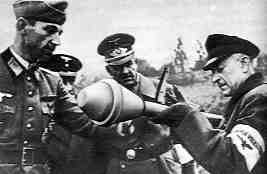 Despite
the seemingly easy usage and the fact that simple usage instructions were
printed onto each weapon, many accidents happened because of wrong handling
of often ill-trained personnel, sometimes also because of material defects
of the weapons themselves.
Despite
the seemingly easy usage and the fact that simple usage instructions were
printed onto each weapon, many accidents happened because of wrong handling
of often ill-trained personnel, sometimes also because of material defects
of the weapons themselves.
Although officially a single-use throw-away weapon, the used tubes of
the all the Panzerfaust weapons were usually collected and returned for
rearmament at the factory.
Faustpatrone
Development of the so-called Faustpatrone ("Fist-Cartridge")
started in the summer of 1942 at the german company HASAG with the development
of the smaller forerunner-prototype called "Gretchen" ("little
Gretel") by a team headed by Dr. Langweiler in Leipzig. The basic
concepts of a recoilless cannon and a rocket were combined into a weapon
for the first time.
 The
following first weapon model of the Panzerfaust-family, the so-called Faustpatrone
klein, 30m ("Fist-Cartridge small") had a total weight of
3.2 kg (7.05lb) and a total length of 98.5 cm (38.78 in.); it's projectile
had a length of 36cm (14.17 in.) and a warhead diameter of 10cm (3.94 in.);
it carried a shaped charge of 400g (14.11oz.) of a 50:50
mix of TNT and Tri-Hexogene. The propellant consisted of 54g
The
following first weapon model of the Panzerfaust-family, the so-called Faustpatrone
klein, 30m ("Fist-Cartridge small") had a total weight of
3.2 kg (7.05lb) and a total length of 98.5 cm (38.78 in.); it's projectile
had a length of 36cm (14.17 in.) and a warhead diameter of 10cm (3.94 in.);
it carried a shaped charge of 400g (14.11oz.) of a 50:50
mix of TNT and Tri-Hexogene. The propellant consisted of 54g 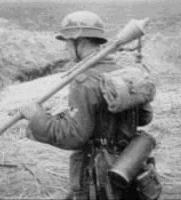 (1.9
oz.) of black powder, the metal launch tube had a length of 80cm (31.5
in.) and a diameter of 3.3cm (1.3 in.) (early models reportedly 2.8cm(1.1in.)).
Fitted to the warhead was a wooden shaft with folded stabilizing fins (made
of 0.25mm (0.01 in.) thick spring metal). These bent blades straightened
into position by themselves as soon as they left the launch tube. The warhead
was accelerated to a speed of 28 m/s (92 fps), had a range of about 30m
(100 ft.) and an armor penetration of up to 140mm (5.5 in.) of plain steel.
Soon a crude aiming device similar to the one used by the Panzerfaust was
added to the design; it was fixed at a range of 30m (100 ft.).
(1.9
oz.) of black powder, the metal launch tube had a length of 80cm (31.5
in.) and a diameter of 3.3cm (1.3 in.) (early models reportedly 2.8cm(1.1in.)).
Fitted to the warhead was a wooden shaft with folded stabilizing fins (made
of 0.25mm (0.01 in.) thick spring metal). These bent blades straightened
into position by themselves as soon as they left the launch tube. The warhead
was accelerated to a speed of 28 m/s (92 fps), had a range of about 30m
(100 ft.) and an armor penetration of up to 140mm (5.5 in.) of plain steel.
Soon a crude aiming device similar to the one used by the Panzerfaust was
added to the design; it was fixed at a range of 30m (100 ft.).
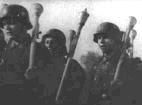 Other
designations of this weapon were Faustpatrone 1 or Panzerfaust
30 klein; however, it was common to refer to this weapon simply as
the Faustpatrone. 20,000 were ordered and the first 500 Faustpatronen
were delivered by the manufacturer, HASAG Hugo Schneider AG, Werk Schlieben,
in August 1943. Two main problems had already surfaced much earlier in
the weapon's trials: First, the original model did not have a sighting
device. Second, due to the odd shape of the warhead (see pictures) it tended
to ricochet off or explode with less effect on sloped armor, especially
on the russian T-34.
Other
designations of this weapon were Faustpatrone 1 or Panzerfaust
30 klein; however, it was common to refer to this weapon simply as
the Faustpatrone. 20,000 were ordered and the first 500 Faustpatronen
were delivered by the manufacturer, HASAG Hugo Schneider AG, Werk Schlieben,
in August 1943. Two main problems had already surfaced much earlier in
the weapon's trials: First, the original model did not have a sighting
device. Second, due to the odd shape of the warhead (see pictures) it tended
to ricochet off or explode with less effect on sloped armor, especially
on the russian T-34.  Since
these problems surfaced already early in testing, the development and production
of it's successor, the Panzerfaust 30, had already begun by the
time of the first deliveries. Still, the small and simple Faustpatrone
klein was kept in production well into 1945.
Since
these problems surfaced already early in testing, the development and production
of it's successor, the Panzerfaust 30, had already begun by the
time of the first deliveries. Still, the small and simple Faustpatrone
klein was kept in production well into 1945.
Panzerfaust 30
 Initially
designated Faustpatrone gross or Faustpatrone 2, this larger
weapon quickly adopted the suggestive
Initially
designated Faustpatrone gross or Faustpatrone 2, this larger
weapon quickly adopted the suggestive
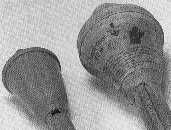 name
Panzerfaust ("Tank-Fist") and the weapons with the larger
warheads were henceforth commonly referred to under that name. The first
direct successor model to the Fautpatrone klein was the Panzerfaust
30 m, developed to iron out the problems encountered during early trials
with the Faustpatrone klein, providing for sights - fixed at 30m
(100 ft. ) range - and a change in the warhead's shape. The Panzerfaust
30 too was developed by Dr. Langweiler's team.
name
Panzerfaust ("Tank-Fist") and the weapons with the larger
warheads were henceforth commonly referred to under that name. The first
direct successor model to the Fautpatrone klein was the Panzerfaust
30 m, developed to iron out the problems encountered during early trials
with the Faustpatrone klein, providing for sights - fixed at 30m
(100 ft. ) range - and a change in the warhead's shape. The Panzerfaust
30 too was developed by Dr. Langweiler's team.
As the next step in development it therefore increased the warhead diameter
to 14cm (5.5 in.) which increased the contact area to a 5cm-diameter (1.97
in.). The charge's amount of explosives was doubled (800g - 28.2oz.) which
in turn increased penetration to 200mm (7.87 in.).
Because of the greatly increased overall size of the warhead the stabilizing
 fins
accordingly were considerably enlarged
fins
accordingly were considerably enlarged
( left: Faustpatrone klein - projectile, right: Panzerfaust
- projectile ), too.
The new tube had a diameter of 4.4cm (1.73 in.), the propellant 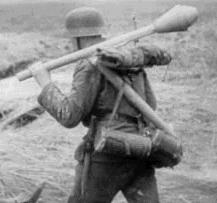 now
weighed 95g (3.35 oz.); the projectile now measured 49.5cm (19.49 in.)
and weighed 2.9kg (6.39 lb). The resulting projectile velocity was 30m/s
(100 fps) which again made for a range of roughly 30m (100 ft.). The complete
weapon now weighed 5,1 kg (11.23 lb) and had a length of 104.5cm (41.14
in.) (other sources: 103cm). Panzerfausts were supplied and transported
in wooden crates that contained four complete weapons.
now
weighed 95g (3.35 oz.); the projectile now measured 49.5cm (19.49 in.)
and weighed 2.9kg (6.39 lb). The resulting projectile velocity was 30m/s
(100 fps) which again made for a range of roughly 30m (100 ft.). The complete
weapon now weighed 5,1 kg (11.23 lb) and had a length of 104.5cm (41.14
in.) (other sources: 103cm). Panzerfausts were supplied and transported
in wooden crates that contained four complete weapons.
Deliveries on the first order of 50,000 began in August 1943 with 6,800
pieces. Production ran until August 1944, then it was switched over to
successor, the Panzerfaust 60. The first large quantity of this
weapon made available to the Wehrmacht, the german armed forces, was the
delivery of 8700 pieces in September 1943.
Panzerfaust 60
 Since
the small distance of 30m to the target tank necessary for the use of the
Panzerfaust 30 m was considered too dangerous, the propellant of
the successor model Panzerfaust 60 m was increased to 134g (4.73
oz) in the next development. This increased projectile velocity to 45 m/s
(150 fps) which made for a practical range of now 60m (200 ft.).
Since
the small distance of 30m to the target tank necessary for the use of the
Panzerfaust 30 m was considered too dangerous, the propellant of
the successor model Panzerfaust 60 m was increased to 134g (4.73
oz) in the next development. This increased projectile velocity to 45 m/s
(150 fps) which made for a practical range of now 60m (200 ft.). 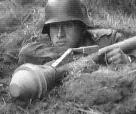 The
sight reflected this with crevices for ranges of 30, 60 and 80 meters (100,
200 and 260 ft. resp.). Tube diameter increased to 5cm (1.97in.). Again,
these developments were made by Dr. Langweiler for the company HASAG. Other
changes included the new arming / firing system with the new lever that
also served as the rear sight. This new model, the Panzerfaust 60 m,
was to become the most popular and widely - used Panzerfaust type. The
weapon had the same length as its forerunner but now weighed 6.1 kg (13.4
lb.). It replaced the Panzerfaust 30 m, production started in September
1944. Early production plans for the Panzerfaust called for 400,000 pieces
per month. This figure was not met until October 1944. By then the request
had been increased in September to 1.5 million per month, this was almost
achieved in December 1944 with close to 1.3 million produced. A large number
of different companies produced the Panzerfaust, the major contributor
was the HASAG Hugo Schneider AG Lampenfabrik in Leipzig.
The
sight reflected this with crevices for ranges of 30, 60 and 80 meters (100,
200 and 260 ft. resp.). Tube diameter increased to 5cm (1.97in.). Again,
these developments were made by Dr. Langweiler for the company HASAG. Other
changes included the new arming / firing system with the new lever that
also served as the rear sight. This new model, the Panzerfaust 60 m,
was to become the most popular and widely - used Panzerfaust type. The
weapon had the same length as its forerunner but now weighed 6.1 kg (13.4
lb.). It replaced the Panzerfaust 30 m, production started in September
1944. Early production plans for the Panzerfaust called for 400,000 pieces
per month. This figure was not met until October 1944. By then the request
had been increased in September to 1.5 million per month, this was almost
achieved in December 1944 with close to 1.3 million produced. A large number
of different companies produced the Panzerfaust, the major contributor
was the HASAG Hugo Schneider AG Lampenfabrik in Leipzig.
Panzerfaust 100
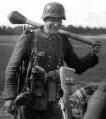 Further
development lead to a new firing tube with a two-stage propellant of now
190g (6.7 oz), resulting in a projectile speed of 60m/s (200 fps) and a
range of 100m (330 ft.). Consequently the model was termed Panzerfaust
100 m and deliveries started in November 1944. The weapon's outward
appearance remained largely unchanged by this modification, not even the
tube was
Further
development lead to a new firing tube with a two-stage propellant of now
190g (6.7 oz), resulting in a projectile speed of 60m/s (200 fps) and a
range of 100m (330 ft.). Consequently the model was termed Panzerfaust
100 m and deliveries started in November 1944. The weapon's outward
appearance remained largely unchanged by this modification, not even the
tube was lengthened (other sources: increased to 115cm), only the weapon now weighed
6.8 kg (15 lb.), had a tube diameter of 6cm (2.36in.) and the sight was
now creviced for ranges of 30, 60, 80 and 150m (100, 200, 260 and 490 ft.
resp.). The crevices now also featured glow paint chips for firing at night.
lengthened (other sources: increased to 115cm), only the weapon now weighed
6.8 kg (15 lb.), had a tube diameter of 6cm (2.36in.) and the sight was
now creviced for ranges of 30, 60, 80 and 150m (100, 200, 260 and 490 ft.
resp.). The crevices now also featured glow paint chips for firing at night.
Panzerfaust 150
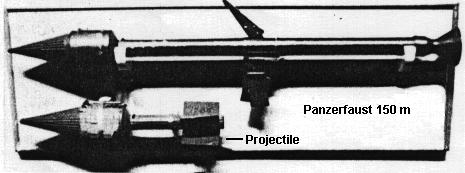 The
Panzerfaust 150 was a major redesign (see picture). Development
began in January 1945, again at the company HASAG. The reinforced firing
tube now was reusable for up to 10 shots. The completely newly designed
warhead now was more pointed, resulting in a new projectile length of 56cm
(22 in.). The pointed warhead increased detonation distance from the target
surface, which together with a new explosive material made for an increased
armor penetration performance of over 200mm (7.87 in.) although less explosive
was used. Propellant amount was increased as well, which with a projectile
speed of 85 m/s (280 fps) accounted for the range of 150m (490 ft.). In
March 1945 orders for a first production run of 100,000 were made and production
started, but only a very small number was actually delivered to the army
before the war's end.
The
Panzerfaust 150 was a major redesign (see picture). Development
began in January 1945, again at the company HASAG. The reinforced firing
tube now was reusable for up to 10 shots. The completely newly designed
warhead now was more pointed, resulting in a new projectile length of 56cm
(22 in.). The pointed warhead increased detonation distance from the target
surface, which together with a new explosive material made for an increased
armor penetration performance of over 200mm (7.87 in.) although less explosive
was used. Propellant amount was increased as well, which with a projectile
speed of 85 m/s (280 fps) accounted for the range of 150m (490 ft.). In
March 1945 orders for a first production run of 100,000 were made and production
started, but only a very small number was actually delivered to the army
before the war's end.
Panzerfaust 250
The last development of the Panzerfaust-series was the Panzerfaust
250. It used a reloadable tube and now featured a pistol grip. With
propellants in both the firing tube and on the projectile itself it was
projected to reach a projectile speed of 150 m/s (490 fps). Serial production
was scheduled to begin in September 1945. However, the development of this
weapon never got completed and not a single one was produced.
Grosse Panzerfaust / Hecht 10,5cm
Early 1945 rumors, mostly from prisoner interrogations, had it that
the russians were about to introduce a new heavily armored superheavy tank,
called the "Schtschuka" (russian; "Pike"), into service
at the eastern front soon. Immediately work on a corresponding anti-tank
weapon began.
The submission from the company HASAG envisioned a so-called Grosse
Panzerfaust ("Large Tank-Fist") based on the tube of the
Panzerfaust 250 and a warhead capable of penetrating 400mm (15.75
in.) of steel.
Dynamit Nobel, another company, suggested the Hecht 10,5cm ("Pike",
obviously because of its intended target) , a combination of the old Pionierhohlladung
H 15 ("Engineer Shape Charge"), of which over 6000 were still
in the armories, with the rocket propellant stage of the old RZ 65, an
aircraft smoke rocket the Luftwaffe had never used in action. Diameter
of the warhead would have been 26.5 cm (10.43 in.), the projectile itself
would have been almost 90cm (35.43 in.) long. The firing tube had a caliber
of 10.5cm (4.13 in.). Besides the fact that rarely any of the RZ 65s were
left (most had been scrapped), trials showed that at least two propellants
would have been necessary to shoot the warhead, which weighed over 15 kg
(33 lb), to a distance of 100m (330 ft.).
Finally it was agreed upon a projected compromise of a new 7kg (15.4 pounds)
shaped charge that was to have a range of 100m (330 ft.). Both the russian
tank with the reported armor of 300 - 400mm (11.8 - 15.75 inch) and the
AT weapon intended to counter it never materialized.
Panzerfaust Developments
Many Panzerfaust modifications were undertaken. Some developments
concerned the use of the Panzerfaust as a weapon against infantry. One
of the projects had a small rocket, the Kleinrakete zur Infanteriebekämpfung
("small rocket for fighting against infantry") with a length
(projectile) of 66cm (26 in.) use the tube of the Panzerfaust. The rocket's
warhead had a length of 24.5cm (9.65 in.) and a diameter of 7.6cm (3 in.)
and consisted of concrete mixed with scrap metal. It was to close the range
gap between the maximum hand grenade range (up to 40m / 130 ft.) and the
minimum mortar range. However this range gap was also filled with the rifle
grenade; only few pre-serial samples of this anti-infantry Panzerfaust
were built.
 In
late 1944 it was suggested to attack both the tank and the infantry riding
on it ( as was custom especially among the russian Red Army ) with the
Panzerfaust. This was implemented in the Panzerfaust 150 and it's projectile
provided for the attachment of Splitterringe ("shrapnel rings")
as an anti-personnel device, similar to the ones that could be put on hand
grenades to increase their fragmentation effect.
In
late 1944 it was suggested to attack both the tank and the infantry riding
on it ( as was custom especially among the russian Red Army ) with the
Panzerfaust. This was implemented in the Panzerfaust 150 and it's projectile
provided for the attachment of Splitterringe ("shrapnel rings")
as an anti-personnel device, similar to the ones that could be put on hand
grenades to increase their fragmentation effect.
Another development was the Schrappnellfaust ("Shrapnel Fist"),
a Panzerfaust-like but reloadable weapon designed to attack infantry. It
weighed 8kg (17.6 lb)and projected its warhead to a range of up to 400m
(440 yd.). A time fuse detonated the warhead as an airburst at 2 - 3 meters
(6.5 - 10 ft.) above ground. About hundred were undergoing weapon trials
with the Wehrmacht when the war ended.
In January 1945 a new warhead for the Panzerfaust was developed under the
designation Verbesserte Panzerfaust ("Improved Tank fist").
It had a diameter of 160mm (6.3 in.) with a customizable variable detonation
distance. An order for 350 was placed, however due to an argument over
who was to produce it the start of production was delayed. It's unclear
wether any were ever delivered to the armed forces.
February 1945 saw the start of a project to manufacture the shaped charge
from the new "Nipolite" explosive. This new explosive
didn't require a metal casing anymore and the shaping of the warhead's
explosive shape charge could be easily made out of the Nipolite on a turning-lathe.
Both simplified production a lot but again the war ended before mass production
begun.
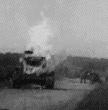 Another
February 1945 proposal for a modification addressed the problem that although
a Panzerfaust would knock out a tank and incapacitate the crew, the tank
itself often could be quickly repaired and be put back into service: if
the tank did not burn out from being set afire from the Panzerfaust hit
then all that remained was the little hole it had made. The idea now was
to add a tank
Another
February 1945 proposal for a modification addressed the problem that although
a Panzerfaust would knock out a tank and incapacitate the crew, the tank
itself often could be quickly repaired and be put back into service: if
the tank did not burn out from being set afire from the Panzerfaust hit
then all that remained was the little hole it had made. The idea now was
to add a tank  gun
incendiary round (Panzerbrandgranate) to follow the Panzerfaust's
shaped charge warhead into the tank and set it on fire. This project too
never realized.
gun
incendiary round (Panzerbrandgranate) to follow the Panzerfaust's
shaped charge warhead into the tank and set it on fire. This project too
never realized.
Other late war projects that never realized fully were the Gasfaust
that was contain a chemical warhead with tear gas such as CN, the Brandfaust
with an incendiary warhead and the Flammfaust that was to contain
flammable liquid; the Flammfaust by the way has nothing to do with the
single-use Einstossflammenwerfer
discussed in connection with the flamethrowers; instead, it was to have
a seperate warhead that contained the liquid and exploded into a fiery
burst at impact.
The Luftfaust ("air fist") was an anti-aircraft, recoilless
shoulder-fired weapon not really related to the Panzerfaust. There were
two versions: the original Luftfaust-A featured four barrels of
2cm-caliber, firing 2cm-projectiles that weighed 90g and contained 19g
of explosive, the projectiles were fitted to a little rocket stage. When
fired in a salvo, the projectiles reached a velocity of 380 m/s.
The Luftfaust-B addressed the problem of the inaccurate and unsatisfactory
hit groups achieved by the Luftfaust-A by kengthening the barrels and increasing
the number of barrels to nine. The weapon now had a length of 150cm and
weighed 6.5 kg. The nine projectiles were shot in one salvo with 0.2 sec.
between the individual barrels. Although large orders for the weapon were
placed in 1945, actually only 80 of these weapons were used in combat trials.
The Fliegerfaust ("airplane fist") had the same basic
design of the Luftfaust but featured six barrels with a diameter of 3cm.
It was to use the 3cm - projectiles of the Maschinenkanone MK108 machine-cannon
used in fighter aircraft such as the Me262 jet. These bullets weighed 330g
and contained 75g of explosives. The weapon did not advance beyond the
trial stage.
Previous Page : The Shaped
Charge Main
Page
Next Page : Panzerschreck
© 1998, 1999, 2000, 2001 created by M.Hofbauer August
29th 1998; document ver. 1.4 mod 150102
This page has been constructed with own material as far
as possible, the third party images and information used herein are public
domain to the best of my knowledge. The author went to considerable lengths
to ensure accordance with the rights of copyright owners where applicable;
respective consent is documented. If you feel injured in your rights by
/ take offense at - any part of this page's content contact
me immediately for redress / possible removal of the respective part.
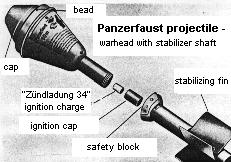

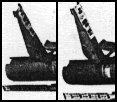 Aiming
was done with said sighting device -creviced for different ranges- as notch,
the bead was a little stump on the projectile (pictures at right: left
lever from Panzerfaust 60, right from Panzerfaust 100).
Aiming
was done with said sighting device -creviced for different ranges- as notch,
the bead was a little stump on the projectile (pictures at right: left
lever from Panzerfaust 60, right from Panzerfaust 100). 

 Despite
the seemingly easy usage and the fact that simple usage instructions were
printed onto each weapon, many accidents happened because of wrong handling
of often ill-trained personnel, sometimes also because of material defects
of the weapons themselves.
Despite
the seemingly easy usage and the fact that simple usage instructions were
printed onto each weapon, many accidents happened because of wrong handling
of often ill-trained personnel, sometimes also because of material defects
of the weapons themselves. The
following first weapon model of the Panzerfaust-family, the so-called Faustpatrone
klein, 30m ("Fist-Cartridge small") had a total weight of
3.2 kg (7.05lb) and a total length of 98.5 cm (38.78 in.); it's projectile
had a length of 36cm (14.17 in.) and a warhead diameter of 10cm (3.94 in.);
it carried a shaped charge of 400g (14.11oz.) of a
The
following first weapon model of the Panzerfaust-family, the so-called Faustpatrone
klein, 30m ("Fist-Cartridge small") had a total weight of
3.2 kg (7.05lb) and a total length of 98.5 cm (38.78 in.); it's projectile
had a length of 36cm (14.17 in.) and a warhead diameter of 10cm (3.94 in.);
it carried a shaped charge of 400g (14.11oz.) of a  (1.9
oz.) of black powder, the metal launch tube had a length of 80cm (31.5
in.) and a diameter of 3.3cm (1.3 in.) (early models reportedly 2.8cm(1.1in.)).
Fitted to the warhead was a wooden shaft with folded stabilizing fins (made
of 0.25mm (0.01 in.) thick spring metal). These bent blades straightened
into position by themselves as soon as they left the launch tube. The warhead
was accelerated to a speed of 28 m/s (92 fps), had a range of about 30m
(100 ft.) and an armor penetration of up to 140mm (5.5 in.) of plain steel.
Soon a crude aiming device similar to the one used by the Panzerfaust was
added to the design; it was fixed at a range of 30m (100 ft.).
(1.9
oz.) of black powder, the metal launch tube had a length of 80cm (31.5
in.) and a diameter of 3.3cm (1.3 in.) (early models reportedly 2.8cm(1.1in.)).
Fitted to the warhead was a wooden shaft with folded stabilizing fins (made
of 0.25mm (0.01 in.) thick spring metal). These bent blades straightened
into position by themselves as soon as they left the launch tube. The warhead
was accelerated to a speed of 28 m/s (92 fps), had a range of about 30m
(100 ft.) and an armor penetration of up to 140mm (5.5 in.) of plain steel.
Soon a crude aiming device similar to the one used by the Panzerfaust was
added to the design; it was fixed at a range of 30m (100 ft.).  Other
designations of this weapon were Faustpatrone 1 or Panzerfaust
30 klein; however, it was common to refer to this weapon simply as
the Faustpatrone. 20,000 were ordered and the first 500 Faustpatronen
were delivered by the manufacturer, HASAG Hugo Schneider AG, Werk Schlieben,
in August 1943. Two main problems had already surfaced much earlier in
the weapon's trials: First, the original model did not have a sighting
device. Second, due to the odd shape of the warhead (see pictures) it tended
to ricochet off or explode with less effect on sloped armor, especially
on the russian T-34.
Other
designations of this weapon were Faustpatrone 1 or Panzerfaust
30 klein; however, it was common to refer to this weapon simply as
the Faustpatrone. 20,000 were ordered and the first 500 Faustpatronen
were delivered by the manufacturer, HASAG Hugo Schneider AG, Werk Schlieben,
in August 1943. Two main problems had already surfaced much earlier in
the weapon's trials: First, the original model did not have a sighting
device. Second, due to the odd shape of the warhead (see pictures) it tended
to ricochet off or explode with less effect on sloped armor, especially
on the russian T-34.  Since
these problems surfaced already early in testing, the development and production
of it's successor, the Panzerfaust 30, had already begun by the
time of the first deliveries. Still, the small and simple Faustpatrone
klein was kept in production well into 1945.
Since
these problems surfaced already early in testing, the development and production
of it's successor, the Panzerfaust 30, had already begun by the
time of the first deliveries. Still, the small and simple Faustpatrone
klein was kept in production well into 1945. Initially
designated Faustpatrone gross or Faustpatrone 2, this larger
weapon quickly adopted the suggestive
Initially
designated Faustpatrone gross or Faustpatrone 2, this larger
weapon quickly adopted the suggestive
 name
Panzerfaust ("Tank-Fist") and the weapons with the larger
warheads were henceforth commonly referred to under that name. The first
direct successor model to the Fautpatrone klein was the Panzerfaust
30 m, developed to iron out the problems encountered during early trials
with the Faustpatrone klein, providing for sights - fixed at 30m
(100 ft. ) range - and a change in the warhead's shape. The Panzerfaust
30 too was developed by Dr. Langweiler's team.
name
Panzerfaust ("Tank-Fist") and the weapons with the larger
warheads were henceforth commonly referred to under that name. The first
direct successor model to the Fautpatrone klein was the Panzerfaust
30 m, developed to iron out the problems encountered during early trials
with the Faustpatrone klein, providing for sights - fixed at 30m
(100 ft. ) range - and a change in the warhead's shape. The Panzerfaust
30 too was developed by Dr. Langweiler's team. now
weighed 95g (3.35 oz.); the projectile now measured 49.5cm (19.49 in.)
and weighed 2.9kg (6.39 lb). The resulting projectile velocity was 30m/s
(100 fps) which again made for a range of roughly 30m (100 ft.). The complete
weapon now weighed 5,1 kg (11.23 lb) and had a length of 104.5cm (41.14
in.) (other sources: 103cm). Panzerfausts were supplied and transported
in wooden crates that contained four complete weapons.
now
weighed 95g (3.35 oz.); the projectile now measured 49.5cm (19.49 in.)
and weighed 2.9kg (6.39 lb). The resulting projectile velocity was 30m/s
(100 fps) which again made for a range of roughly 30m (100 ft.). The complete
weapon now weighed 5,1 kg (11.23 lb) and had a length of 104.5cm (41.14
in.) (other sources: 103cm). Panzerfausts were supplied and transported
in wooden crates that contained four complete weapons. Since
the small distance of 30m to the target tank necessary for the use of the
Panzerfaust 30 m was considered too dangerous, the propellant of
the successor model Panzerfaust 60 m was increased to 134g (4.73
oz) in the next development. This increased projectile velocity to 45 m/s
(150 fps) which made for a practical range of now 60m (200 ft.).
Since
the small distance of 30m to the target tank necessary for the use of the
Panzerfaust 30 m was considered too dangerous, the propellant of
the successor model Panzerfaust 60 m was increased to 134g (4.73
oz) in the next development. This increased projectile velocity to 45 m/s
(150 fps) which made for a practical range of now 60m (200 ft.).  The
sight reflected this with crevices for ranges of 30, 60 and 80 meters (100,
200 and 260 ft. resp.). Tube diameter increased to 5cm (1.97in.). Again,
these developments were made by Dr. Langweiler for the company HASAG. Other
changes included the new arming / firing system with the new lever that
also served as the rear sight. This new model, the Panzerfaust 60 m,
was to become the most popular and widely - used Panzerfaust type. The
weapon had the same length as its forerunner but now weighed 6.1 kg (13.4
lb.). It replaced the Panzerfaust 30 m, production started in September
1944. Early production plans for the Panzerfaust called for 400,000 pieces
per month. This figure was not met until October 1944. By then the request
had been increased in September to 1.5 million per month, this was almost
achieved in December 1944 with close to 1.3 million produced. A large number
of different companies produced the Panzerfaust, the major contributor
was the HASAG Hugo Schneider AG Lampenfabrik in Leipzig.
The
sight reflected this with crevices for ranges of 30, 60 and 80 meters (100,
200 and 260 ft. resp.). Tube diameter increased to 5cm (1.97in.). Again,
these developments were made by Dr. Langweiler for the company HASAG. Other
changes included the new arming / firing system with the new lever that
also served as the rear sight. This new model, the Panzerfaust 60 m,
was to become the most popular and widely - used Panzerfaust type. The
weapon had the same length as its forerunner but now weighed 6.1 kg (13.4
lb.). It replaced the Panzerfaust 30 m, production started in September
1944. Early production plans for the Panzerfaust called for 400,000 pieces
per month. This figure was not met until October 1944. By then the request
had been increased in September to 1.5 million per month, this was almost
achieved in December 1944 with close to 1.3 million produced. A large number
of different companies produced the Panzerfaust, the major contributor
was the HASAG Hugo Schneider AG Lampenfabrik in Leipzig. Further
development lead to a new firing tube with a two-stage propellant of now
190g (6.7 oz), resulting in a projectile speed of 60m/s (200 fps) and a
range of 100m (330 ft.). Consequently the model was termed Panzerfaust
100 m and deliveries started in November 1944. The weapon's outward
appearance remained largely unchanged by this modification, not even the
tube was
Further
development lead to a new firing tube with a two-stage propellant of now
190g (6.7 oz), resulting in a projectile speed of 60m/s (200 fps) and a
range of 100m (330 ft.). Consequently the model was termed Panzerfaust
100 m and deliveries started in November 1944. The weapon's outward
appearance remained largely unchanged by this modification, not even the
tube was lengthened (other sources: increased to 115cm), only the weapon now weighed
6.8 kg (15 lb.), had a tube diameter of 6cm (2.36in.) and the sight was
now creviced for ranges of 30, 60, 80 and 150m (100, 200, 260 and 490 ft.
resp.). The crevices now also featured glow paint chips for firing at night.
lengthened (other sources: increased to 115cm), only the weapon now weighed
6.8 kg (15 lb.), had a tube diameter of 6cm (2.36in.) and the sight was
now creviced for ranges of 30, 60, 80 and 150m (100, 200, 260 and 490 ft.
resp.). The crevices now also featured glow paint chips for firing at night. The
Panzerfaust 150 was a major redesign (see picture). Development
began in January 1945, again at the company HASAG. The reinforced firing
tube now was reusable for up to 10 shots. The completely newly designed
warhead now was more pointed, resulting in a new projectile length of 56cm
(22 in.). The pointed warhead increased detonation distance from the target
surface, which together with a new explosive material made for an increased
armor penetration performance of over 200mm (7.87 in.) although less explosive
was used. Propellant amount was increased as well, which with a projectile
speed of 85 m/s (280 fps) accounted for the range of 150m (490 ft.). In
March 1945 orders for a first production run of 100,000 were made and production
started, but only a very small number was actually delivered to the army
before the war's end.
The
Panzerfaust 150 was a major redesign (see picture). Development
began in January 1945, again at the company HASAG. The reinforced firing
tube now was reusable for up to 10 shots. The completely newly designed
warhead now was more pointed, resulting in a new projectile length of 56cm
(22 in.). The pointed warhead increased detonation distance from the target
surface, which together with a new explosive material made for an increased
armor penetration performance of over 200mm (7.87 in.) although less explosive
was used. Propellant amount was increased as well, which with a projectile
speed of 85 m/s (280 fps) accounted for the range of 150m (490 ft.). In
March 1945 orders for a first production run of 100,000 were made and production
started, but only a very small number was actually delivered to the army
before the war's end. In
late 1944 it was suggested to attack both the tank and the infantry riding
on it ( as was custom especially among the russian Red Army ) with the
Panzerfaust. This was implemented in the Panzerfaust 150 and it's projectile
provided for the attachment of Splitterringe ("shrapnel rings")
as an anti-personnel device, similar to the ones that could be put on hand
grenades to increase their fragmentation effect.
In
late 1944 it was suggested to attack both the tank and the infantry riding
on it ( as was custom especially among the russian Red Army ) with the
Panzerfaust. This was implemented in the Panzerfaust 150 and it's projectile
provided for the attachment of Splitterringe ("shrapnel rings")
as an anti-personnel device, similar to the ones that could be put on hand
grenades to increase their fragmentation effect. Another
February 1945 proposal for a modification addressed the problem that although
a Panzerfaust would knock out a tank and incapacitate the crew, the tank
itself often could be quickly repaired and be put back into service: if
the tank did not burn out from being set afire from the Panzerfaust hit
then all that remained was the little hole it had made. The idea now was
to add a tank
Another
February 1945 proposal for a modification addressed the problem that although
a Panzerfaust would knock out a tank and incapacitate the crew, the tank
itself often could be quickly repaired and be put back into service: if
the tank did not burn out from being set afire from the Panzerfaust hit
then all that remained was the little hole it had made. The idea now was
to add a tank  gun
incendiary round (Panzerbrandgranate) to follow the Panzerfaust's
shaped charge warhead into the tank and set it on fire. This project too
never realized.
gun
incendiary round (Panzerbrandgranate) to follow the Panzerfaust's
shaped charge warhead into the tank and set it on fire. This project too
never realized.